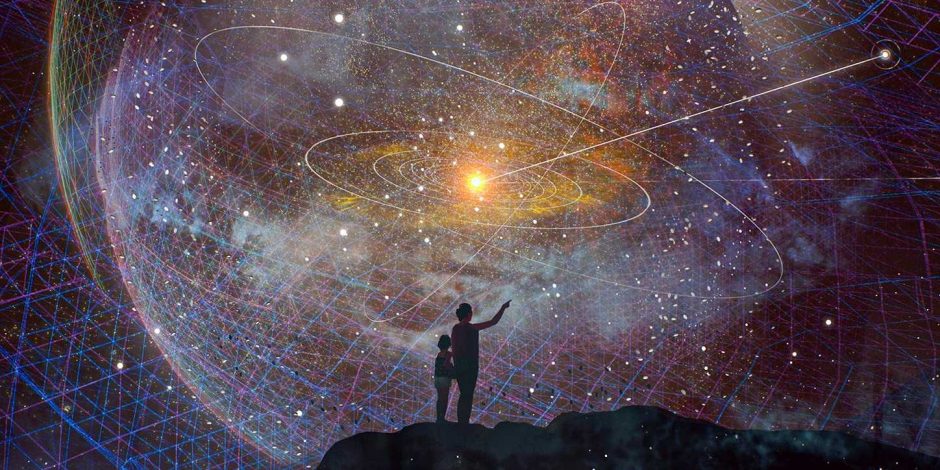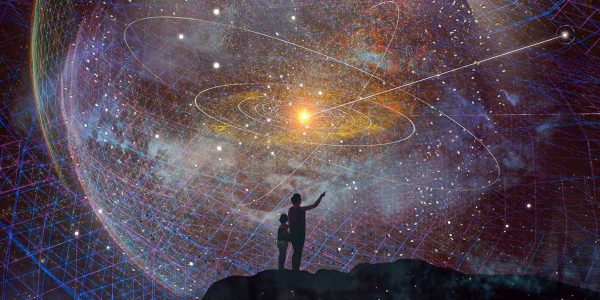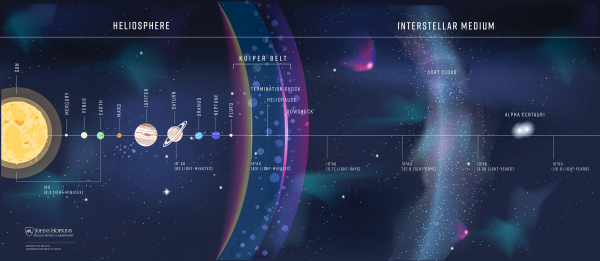Looking out of the bubble

An ambitious space mission could open the way to a better understanding of our heliosphere and of cosmic dust. NCCR PlanetS project leader Dr Veerle Sterken and her team recently published a paper in support of such an ambitious mission which was detailing potential science outcomes for the dust and heliospheric sciences, as well as describing the technical requirements needed to achieve this.
For about a year, the US National Academies of Sciences, Engineering, and Medicine has been reviewing a large number of scientific studies in what is called the Decadal Survey for Solar and Space Physics (Heliophysics). Decadal Surveys are community-informed processes meant to set a field’s scientific priorities for the following decade: stakes are high – the proposed science and space missions can be very ambitious and projected budgets can be staggering. One concept study under consideration, known as Interstellar Probe, boldly ticks both boxes.
The Interstellar Probe concept is to send a spacecraft out of our heliosphere and into interstellar space, following the steps of Voyager 1 and 2 and, crucially, addressing the many questions left open by data collected by the Voyager probes as they ventured out of the region dominated by our star. The Interstellar Probe mission would be designed for a nominal lifetime of 50 years and would cost 1.7 billion US dollars to develop (including 50% reserve).
Among the white papers in support of Interstellar Probe is one whose lead author, Dr Veerle Sterken, heads an ERC-funded group in the Institute for Particle Physics and Astrophysics studying cosmic dust inside and outside the Solar System. In this document, Sterken and her colleagues discuss how important a mission such as Interstellar Probe would be to further knowledge in dust science and heliospheric research, as well as to learn more about the interaction between dust and heliosphere. An extended version of the white paper was published recently in the journal RAS Techniques and Instruments (RASTI).

The concept study for Interstellar Probe is currently under review in the Decadal Survey for Solar and Space Physics. (Image: Johns Hopkins APL)
A little-known cosmic neighborhood
The Solar System finds itself in a ‘bubble’, called the heliosphere, which is surrounded by interstellar medium and is continuously filled with plasma from the Sun known as the solar wind. The latter travels far and wide until it reaches the termination shock, a boundary where its propagation slows down significantly due to pressure from the outer interstellar medium. Between the termination shock and the heliosphere’s edge (called the heliopause) is the area referred to as the heliosheath.
Even though these regions are our neighborhood (in astronomical terms), they are still largely unknown. The debate on the overall shape of the heliosphere is open: it was thought to be comet-shaped, but other hypotheses point to spherical or croissant-like shapes. Similarly, models predict a heliosheath twice the thickness than what is suggested by existing data, and the interaction between solar wind and dust isn’t well-understood.
Interstellar dust, which is thought to populate the Universe, is where the building blocks for stars and planets come from. The study of dust particles – what their characteristics are, and how they move through space – is relevant to areas ranging from astrochemistry to observational astronomy and, as is now increasingly clear, to heliophysics.

The Interstellar Probe mission would allow scientists to learn more about our heliosphere and what lies beyond it. (Image: Johns Hopkins APL)
Out of the bubble
Knowledge of interstellar dust is patchy. There exist notable discrepancies on the size distribution and composition of contemporary interstellar dust particles between current astronomical models and data from in-situ measurements. A possible explanation for such discrepancies is a filtering operated by our heliosphere, which would block smaller dust particles depending on the phase of the solar magnetic activity cycle. The issue is that currently available in-situ data were collected within the heliosphere; they also come partly from space probes that didn’t count cosmic dust research among their primary objectives. According to Sterken, getting out of the heliosphere would boost the number of measured interstellar dust particles by a factor of 10,000 with respect to measurements from within the bubble. This prospect alone makes a mission like Interstellar Probe invaluable.
On its voyage, Interstellar Probe could carry out in-situ measurements of dust and plasma parameters in all relevant regions – in interplanetary space, at the termination shock, in the heliosheath and at the heliopause – before leaving our neighborhood. Dust modelling based on such measurements would allow scientists to include new constraints from dust science into heliosphere models, which are already informed by magnetic-field, plasma and galactic cosmic-ray data. An open question that could benefit from adding dust to the picture is how the heliospheric structure varies over time. Another question that could be answered by improved in-situ measurements is whether dust particles – and which size of particles – play a role in the pressure balance of the heliosphere.
This is also a serendipitous time to plan an escape from our bubble. As the Solar System revolves around the center of the galaxy, it crosses regions with different densities of gas and dust. At the moment, it’s headed out of the Local Interstellar Cloud (LIC) – where it has dwelled for about 60,000 years – and into the G Cloud. Recent findings show that the Sun is likely to be already in the transition region between the LIC and the G Cloud, so it ought to be possible to catch glimpses of material from the neighbouring G-cloud region – an exciting opportunity for scientists like Sterken.
Given how important a mission such as Interstellar Probe would be to heliospheric research and dust science, the authors of the RASTI paper make a case for a dedicated, state-of-the-art dust instrument in the Interstellar Probe payload that would gather data offering unprecedented insight into interstellar dust characteristics and dynamics.
Not just about Interstellar Probe
The authors also envisage a synergy between different missions – Interstellar Probe being one of them – to access more vantage points in space simultaneously as well as at different temporal scales for observation. Indeed, instruments carried by distinct missions could provide complementary data and a more complete picture of the increasingly discussed dust-heliosphere interaction. The paper includes a review of existing and near-future instrumentation that could be considered for the Interstellar Probe payload as well as for other spacecrafts. In particular, the authors discuss lower detection limits in particle size and nanodust measurements because, crucially, nanodust particles are abundant in interstellar space but are filtered out by the heliosphere.
Detector calibration is also highly relevant to mission instrumentation, and it’s an aspect on which the Sterken group has worked with scientists from the National Center of Competence in Research (NCCR) PlanetS. As Interstellar Probe would travel fast (it would reach the termination shock in half the time it took the Voyager spacecrafts), its dust detector would need to be calibrated by accounting for high-speed particles and for particle compositions and morphologies so far potentially unacknowledged.
The outcome of the Decadal Survey will be disclosed in 2024, and a positive outcome for Interstellar Probe would be a governing recommendation for NASA. The RASTI paper is authored by many researchers from Europe: this can be seen as a message to ESA that it may be worth contributing to the Interstellar Probe mission also with a dust instrument, should Interstellar Probe go ahead. Until further decisions are made, research into dust and our cosmic neighborhood continues from within the bubble.
This story is based on an article by Gaia Donati from ETH Zurich.
Reference
Sterken, V.J. et al. Synergies between interstellar dust and heliospheric science with an Interstellar Probe. RAS Techniques and Instruments (2023). DOI:10.1093/rasti/rzad034 (Accepted Manuscript)
Further reading
Hunziker, S. et al. Impact ionization dust detection with compact, hollow and fluffy dust analogs. Planetary and Space Science 220, 105536 (2022). DOI:10.1016/j.pss.2022.105536
Brandt, P.C. et al. Future Exploration of the Outer Heliosphere and Very Local Interstellar Medium by Interstellar Probe. Space Sci. Rev. 219, 18 (2023). DOI:10.1007/s11214-022-00943-x
Decadal Survey for Solar and Space Physics (Heliophysics) 2024-2033
Research funding
Dr Sterken’s research project has received funding from the European Research Council (ERC) under the European Union’s Horizon 2020 research and innovation programme (grant agreement No 851544).
This work has also been carried out within the framework of the NCCR PlanetS supported by the Swiss National Science Foundation under grants 51NF40_182901 and 51NF40_205606.
Categories: News
